Special Hobby 1/32 Hawk 75A 'Sussu'
|
KIT: |
Special Hobby 1/32 Hawk 75A 'Sussu' |
|
KIT #: |
? |
|
PRICE: |
9500 yen at
www.hlj.com (about $90.00) |
|
DECALS: |
Two options |
|
REVIEWER: |
Tom
Cleaver |
|
NOTES: |
|
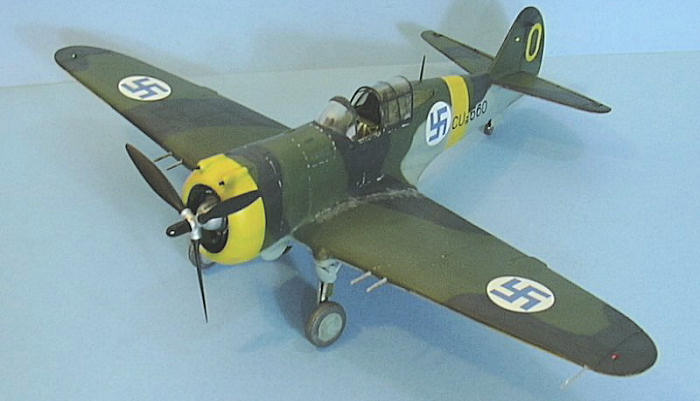
Don Berliner,
Chief Designer of Curtiss-Wright, first set pencil to paper to create the Hawk
75 in 1934, the same year that saw the birth of the Messerschmitt Bf-109, the
Hawker Hurricane and the Supermarine Spitfire.
The design was as revolutionary for
Curtiss - at the time the premier supplier of fighter aircraft to the U.S. Army
Air Corps and the U.S. Navy - as were the other designs for their respective
creators.
It was the first all-metal,
retractable-gear, enclosed-cockpit fighter produced by Curtiss.
While the XP-36 lost the 1937
Fighter Competition to the Seversky P-35, the P-36 came back - powered by a
better engine - to obtain the largest production order from the Army for a
fighter since the First World War, and went on to spawn the P-40.
Curtiss had
always been known for maximizing the export potential of their designs, and the
Hawk 75 was no exception. The largest export order went to the
Armee de l’Air just before the
outbreak of the Second World War. Numerically second only to the Morane-Saulnier
M.S. 406, the Hawk 75 equipped four Groupes de
Chasse at the time of the German invasion on May 10,
1940. French Hawk pilots shot down over 150 German aircraft in the five weeks
they fought the Luftwaffe.
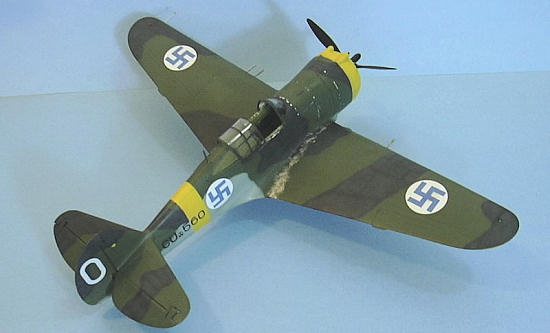 Following the end of the Winter
War, Germany worked hard to make Finland an ally for what the Germans knew would
be a war with the Soviet Union. In October 1940, Germany agreed to sell captured
French Hawk fighters to Finland, and a total of 44 captured aircraft of five
subtypes were sold (at commercial prices higher than those the French had
complained of when they purchased the airplanes from Curtiss-Wright!), with
three deliveries between June 23, 1941 to January 5, 1944. The French aircraft
included Twin-Wasp-powered H-75A-3s and Cyclone-powered H-75A-4s. Additionally,
some Twin Wasp-powered H-75A-6s and Cyclone-powered H-78A-8s initially sold to
Norway and captured in their wooden crates were sold to Finland in early 1941.
Following the end of the Winter
War, Germany worked hard to make Finland an ally for what the Germans knew would
be a war with the Soviet Union. In October 1940, Germany agreed to sell captured
French Hawk fighters to Finland, and a total of 44 captured aircraft of five
subtypes were sold (at commercial prices higher than those the French had
complained of when they purchased the airplanes from Curtiss-Wright!), with
three deliveries between June 23, 1941 to January 5, 1944. The French aircraft
included Twin-Wasp-powered H-75A-3s and Cyclone-powered H-75A-4s. Additionally,
some Twin Wasp-powered H-75A-6s and Cyclone-powered H-78A-8s initially sold to
Norway and captured in their wooden crates were sold to Finland in early 1941.
After
originally being assigned to Lentolaivue
14 and 16 to be used for high-speed reconnaissance, the Hawks were eventually
flown by Lentolaivue 32
throughout their wartime service and were popular with Finnish pilots, who
called it Sussu
("Sweetheart"). The Finns were the most successful operators of the Hawk 75 in
combat, scoring 190.33 kills by 58 pilots, between July 16, 1941 and July 27,
1944, for the loss of 15 Hawks.
After the Armistice, the surviving
Finnish Hawks
remained in service with
HLeLv 13, HLeLv 11 and
LeSK until 1948.
Though only 1,100 Hawk 75s of all
types were produced between 1937-41, the aircraft was used on all operational
fronts against all three Axis powers at one time or another, and was flown by
air forces on both sides!
Kyösti Karhila:
With 13.5 victories scored while
flying the Hawk 75, Kyösti Karhila is the second-highest-scoring Hawk 75 pilot
of the war.
Karhila’s
father had fought during the Liberation War of 1918-19 that founded modern
Finland, and the son felt it his duty to also serve.
At age 16 in 1937, Karhila joined
an Aero Club founded by the National Aviation Association and obtained his A and
B glider licenses over the course of a month.
In the summer of 1939, he completed
35 hours of powered flight training and became a reservist in the Finnish Air
Force, where he began advanced flight training that fall, tarting his military
service on December 6, 1939, Finnish Independence Day.
With 84 other students, he trained
while the Winter War raged, completing his training and receiving his wings just
too late to see combat service.
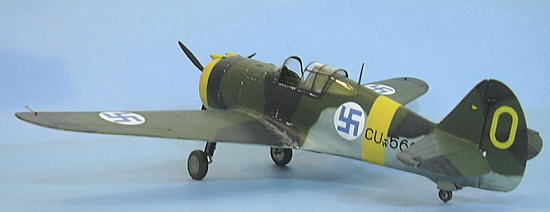
In March 1940,
Karhila and 34 others were selected for a secret mission.
They were to be sent to the UK for
more training and then would ferry Hawker Hurricanes to Finland. The mission was
aborted when the Armistice was on March, 13, 1940. As Karhila recalled to me in
an interview I conducted with him in 2004, “Everything was ready, we even had
our civilian clothing sent from home.”
In April 1940,
Karhila was posted to Lentolaivue 34,
which was equipped with Fokker D.XXIs that were handed down from
Lentolaivue 24,
the unit that had flown them in the Winter War when that squadron re-equipped
with the recently-received Brewster B-234s.
Karhila
completed his 18 months of compulsory service by being promoted to Ensign and
sent home the same day, June 4, 1941. Two weeks later, on June 20, 1941,
he was recalled to active service
and posted to
Lentolaivue 32.
On June 21, the squadron flew their
Fokkers to Hyvinkaa, where they were assigned to the air defense of Helsinki and
the Riihimaki railway crossing.
Ten days later they were
transferred to Utti. During this time, Karhila recalled, “I did fly some
interception missions, but I did not see a single enemy. One of our flights shot
down a couple of bombers east of Helsinki, however.”
Karhila was
assigned as wingman to his Flight Commander, Captain Pate Berg.
Berg had fought in the Winter War
and passed on his knowledge of air combat to his young charges.
Karhila
remembered that “Our task was to defend the town of Kotka and its harbor, and
also the railway crossing at Kouvola. However, we found our Fokkers were totally
obsolete. Our Squadron Leader, Major Ehrnrooth, complained to the Air Force
Headquarters that our squadron could not fulfill our task.”
In mid-July,
Lentolaivue 32 traded their
Fokker D.XXIs for the Curtiss Hawk 75s flown by
Lentolaivue 14 and 16.
Karhila had
good memories of the Hawk.
“The CU was 50km/h faster, and had
retractable undercarriage, along with a better armament. Performance - agility,
climb - was better than the Fokker and the CU was maneuverable.
Technically, it was the state of
the art in those days, in our opinion.”
Karhila
finally saw combat on J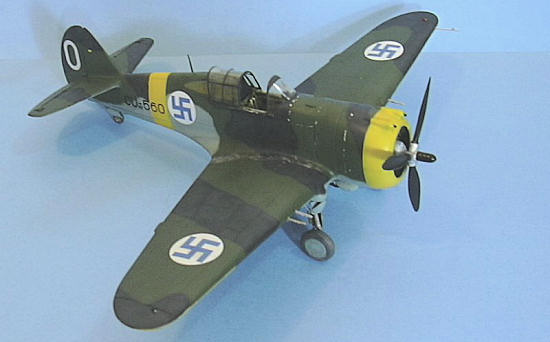 uly
31, 1941. As he remembered, “Major Ehrnrooth was going sight-seeing and asked
for a volunteer wingman and he selected me. We set off to the air base of
Suur-Merijoki, which was now in enemy hands.
When we crossed the front, we were
shot at by heavy AA, which was the first time for me.
He was flying a Cyclone-powered
airplane, and suddenly his oil temperature went up and he had to decrease power.
We didn’t have radios and I wondered why he flew so slowly.
I kept a sharp lookout and spotted
two dots behind us. I kept watching, and they were Russians - two
Tchaikas, I-153's. Since our radios weren’t working,
I added power and went ahead of the Major and signalled him ‘follow me.’
uly
31, 1941. As he remembered, “Major Ehrnrooth was going sight-seeing and asked
for a volunteer wingman and he selected me. We set off to the air base of
Suur-Merijoki, which was now in enemy hands.
When we crossed the front, we were
shot at by heavy AA, which was the first time for me.
He was flying a Cyclone-powered
airplane, and suddenly his oil temperature went up and he had to decrease power.
We didn’t have radios and I wondered why he flew so slowly.
I kept a sharp lookout and spotted
two dots behind us. I kept watching, and they were Russians - two
Tchaikas, I-153's. Since our radios weren’t working,
I added power and went ahead of the Major and signalled him ‘follow me.’
“I turned
against the enemy - they were diving on us from higher altitude.
We turned against them heads-on and
fired. That is the most unpleasant situation, since neither pilot knows which
direction to dodge. If you do not dodge, you will be rammed, but if you dodge
too early, they will get a chance to shoot at you. My Russian did not dodge and
the Tchaika nearly
rammed me. We both banked around and came back at each other. After the third
turn he was gaining on me and I knew I was going to be in trouble.
At about 2000 meters. I pushed over
and dived.
I looked behind to see the Tchaika
tried to follow, but he was left behind. Then I returned to find my leader.
Major
Ehrnrooth had shot down the second Tchaika and shot it down. I joined on his
wing, thinking I was in trouble, that I had
abandoned my leader in the face of
enemy. When we landed, I went to him and attempted to report. He slapped me on
shoulders, and said, ‘That's the way, you saved us both!” He had no idea those
Russians were near till I saw them, and he praised me to heaven.”
On August 10,
1941, flying the Hawk CU-560 that became “his” airplane, and in which he scored
8 of his 13.5 victories in the Hawk.
Karhila recalled, “We met a two
plane patrol.
The leader opened fire as he turned
toward us with 20mm cannons -
the muzzle flashes were tremendous.
We both turned for a second
head-on pass, after which I got
behind him.
He dove vertically and I followed.
I got off a burst and realized we
were too low.
I pulled the stick back so hard I
passed out.
When I came to, I didn’t see the
I-16 anywhere. It was likely he crashed, but I did not see that.
By early 1943,
Karhila was an experience flight leader.
On February 9, 1943, with the unit
based at Nurmoila west of Lake Ladoga, he took part in the ambush of a
reconnaissance mission flown by a Pe-2.
The Pe-2 was so fast that a Hawk
could only catch one if it had an altitude advantage sufficient to build up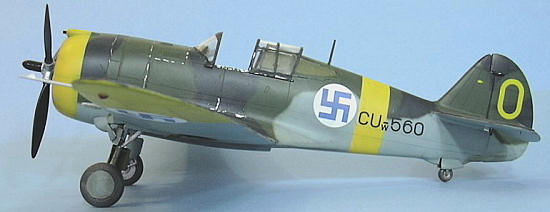 speed in a dive.
As he remembered, “I managed to
surprise a lone Pe-2.
I hit a fuel line in the cockpit
area, a fire broke out in the cockpit and two men bailed out while the Pe-2
crashed in a bog.”
speed in a dive.
As he remembered, “I managed to
surprise a lone Pe-2.
I hit a fuel line in the cockpit
area, a fire broke out in the cockpit and two men bailed out while the Pe-2
crashed in a bog.”
In March 1943,
with 13.5 victories scored in the Hawk 75, Karhila was transferred to HLeLv 34,
commanded by Major Eino Luukkanen, where he transitioned to the Bf-109G.
A week later the second flight was
transferred to HLeLv 30 at Malmi for the defense of Helsinki.
In June 1944, Karhila returned to
HLeLv 34 and flew with the unit until the end of June when he was posted to
command HLeLv 24 after Hasse Wind was wounded.
By the time of the Armistice on
July 27, 1944, Karhila had scored 34 victories, though the last one - gained the
day before the armistice = was not confirmed.
Karhila became
a pilot for Finnair in 1947 and flew until he retired in 1973, working as a
charter pilot until he stopped at age 65 in 1986.
Recalling the two airplanes he flew
in combat, he said “I always liked the way the Hawk flew.
The Messerschmitt was faster and
had heavier armament, but the Hawk was a better flyer.”
Following the basic P-36A in
November 2005, and the “high-tech French Hawk 75A series in 2006, this Hawk is
one of two released by Special Hobby.
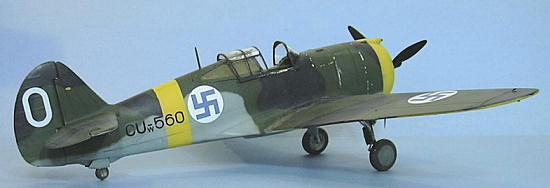 This kit
differs from the previous kits in having parts for both the Pratt and
Whitney-powered H-75A-3/6 and the Cyclone-powered H-75A-4/8.
This is accomplished through an
additional sprue containing the parts for the Cyclone engine and the different
forward fuselage/cowling.
The kit reverts to an all-plastic
cockpit, which is actually superior to the resin cockpit provided in the Azur
“high-tech” kit, since these parts actually fit. A pre-painted photo-etch
instrument panel is also provided, along with seat belts and other cockpit
details in photo-etch.
This kit
differs from the previous kits in having parts for both the Pratt and
Whitney-powered H-75A-3/6 and the Cyclone-powered H-75A-4/8.
This is accomplished through an
additional sprue containing the parts for the Cyclone engine and the different
forward fuselage/cowling.
The kit reverts to an all-plastic
cockpit, which is actually superior to the resin cockpit provided in the Azur
“high-tech” kit, since these parts actually fit. A pre-painted photo-etch
instrument panel is also provided, along with seat belts and other cockpit
details in photo-etch.
Decals are provided for a Hawk
75A-6 flown by Kyösti Karhila with LeLv32 and a Hawk 75A-4 flown by LeLv12.
I chose to do the H-75A-6 flown by
Kyösti Karhila.
The kit breaks
down into two major sub-assemblies: the engine/cowling/main fuselage with
cockpit, and the wings.
I started by
gluing each half of the cowling to the proper fuselage half, and then painted
the interior of the fuselage and cowling, and all the interior parts, with
Interior Green, and painted the details in the cockpit parts.
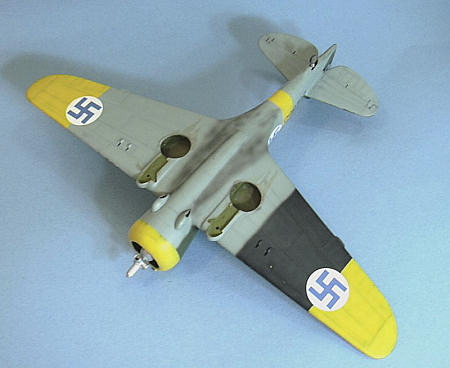 I then built
the very nice R-1820 (Hopefully Tom meant R-1830 as CU-560 was Wasp powered,
thus the 'w' in the serial. Ed), attached it to its bulkhead, then tacked
that to one fuselage half and began test-fitting.
I had to sand down the engine
bulkhead a bit to avoid a large gap between the fuselage halves.
When this was accomplished, I glued
the cockpit side panels in position and glued the fuselage together.
I took this time to attach the part
that forms the tail wheel wall.
I then built
the very nice R-1820 (Hopefully Tom meant R-1830 as CU-560 was Wasp powered,
thus the 'w' in the serial. Ed), attached it to its bulkhead, then tacked
that to one fuselage half and began test-fitting.
I had to sand down the engine
bulkhead a bit to avoid a large gap between the fuselage halves.
When this was accomplished, I glued
the cockpit side panels in position and glued the fuselage together.
I took this time to attach the part
that forms the tail wheel wall.
I then test
fitted and reshaped the forward cockpit bulkhead.
It is essential that this part fits
perfectly inside the fuselage.
I also test-fitted and modified the
rear cockpit in a similar manner.
When that was
accomplished and those parts were correctly glued in position, I assembled the
fuselage weapons, the instrument panel and rudder pedals, and attached that in
position.
I then glued the cockpit floor in
position.
Having learned
my lesson the hard way on the other two P-36/Hawk 75 kits I’ve done, I then
attached the lower wing to the fuselage.
I then test-fitted and reshaped
each upper wing so it would fit to the fuselage and the wing correctly.
When that was done, I assembled the
bulkheads for the main gear well into each upper wing and glued the wings in
position.
I also finished off main assembly
by attaching the horizontal stabilizers.
I then applied liberal amounts of
cyanoacrylate glue to all seams, sanded them down, reapplied more cyanoacrylate,
sanded that down, then applied and reapplied Mr. Surfacer, followed by more
sanding, and more Mr. Surfacer where necessary, the model was finally in shape
and I then rescribed the panel lines that had been lost.
Painting:
The
instructions with the kit recommended an upper surface color of RLM71 and a
lower surface color of RLM65.
This is the scheme the Hawks were
originally delivered in by the Germans, and in which they fought for the first
18 months of the Continuation War.
To tell the truth, I only realized
this fact after I had decided the instructions were wrong and that I would paint
it according to the instructions and color call-outs in the now-OOP Cutting Edge
decal sheet that includes Finnish Hawks.
As it turns out, that later
black/green/light blue scheme was applied to the Hawks after 1943.
It is likely that the black
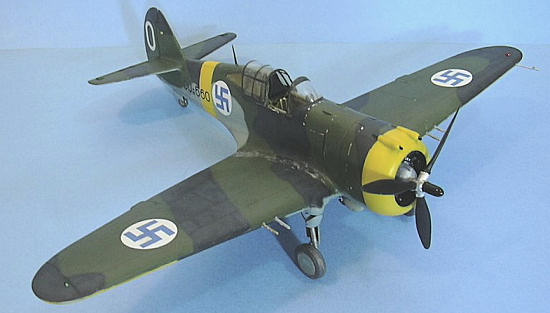 was
field applied over the RLM71 green, and the RLM65 was also applied over that
color on the fuselage sides.
If you are doing a Finnish Hawk 75
in this later scheme, I recommend you use RLM71, black, and RLM65.
If you want to do the early scheme,
the kit instructions are in fact correct.
was
field applied over the RLM71 green, and the RLM65 was also applied over that
color on the fuselage sides.
If you are doing a Finnish Hawk 75
in this later scheme, I recommend you use RLM71, black, and RLM65.
If you want to do the early scheme,
the kit instructions are in fact correct.
I chose to use
Tamiya paints throughout on this project.
I applied Flat Yellow to the nose,
lower wings and fuselage, then masked off those areas.
The lower fuselage was done with
Tamiya “Light Blue” which is actually RLM65, with the upper surfaces done with
“NATO Black” and “NATO Green.”
Decals:
I used the kit
decals for the serial number and aircraft number, and used the national insignia
decals from the Cutting Edge sheet.
These include a smaller insignia
for the upper wing, which is right for the later scheme.
If you are doing the original early
scheme, the national insignia in the kit decals is the correct size.
The photos
in the Squadron book on the Finnish Air Force show the Hawk 75s in this
scheme to be pretty clean, other than lots of dings on the wingwalk area
(the factory-supplied “wing walk” appears to have been removed from the
Finnish airplanes by the time they were repainted).
I applied Tamiya “Mud” to the
wheels and gear wells, and applied exhaust staining.
I then unmasked the cockpit and
installed the canopy in the open position.
I like these
MPM Hawk 75/P-36 kits.
They are not for the beginner due
to the fit problems, but the result is a nice-looking model of an airplane that
was almost never-disliked by any pilot who flew it and performed far better than
the “conventional wisdom” would have one believe.
I am currently doing a Mohawk IV
and a P-36C in the “1938 National Air Races scheme,” which should tell you how
much I like the model.
Information on Kyösti
Karhila from an interview conducted by telephone on November 18, 2004 by Tom
Cleaver.
(An excellent reference on Finnish Hawk 75s is Suomen
Ilmavoimein Historia #5 available at
www.kolumbus.fi/kari.stenman/ Ed)
Tom Cleaver
July 2008
Review kit courtesy of
HobbyLink Japan. Get yours at www.hlj.com
If you would like your product reviewed fairly and quickly, please
contact
me or see other details in the
Note to
Contributors.
Back to the Main Page
Back to the Review
Index Page




 uly
31, 1941. As he remembered, “Major Ehrnrooth was going sight-seeing and asked
for a volunteer wingman and he selected me. We set off to the air base of
Suur-Merijoki, which was now in enemy hands.
When we crossed the front, we were
shot at by heavy AA, which was the first time for me.
He was flying a Cyclone-powered
airplane, and suddenly his oil temperature went up and he had to decrease power.
We didn’t have radios and I wondered why he flew so slowly.
I kept a sharp lookout and spotted
two dots behind us. I kept watching, and they were Russians - two
Tchaikas, I-153's. Since our radios weren’t working,
I added power and went ahead of the Major and signalled him ‘follow me.’
uly
31, 1941. As he remembered, “Major Ehrnrooth was going sight-seeing and asked
for a volunteer wingman and he selected me. We set off to the air base of
Suur-Merijoki, which was now in enemy hands.
When we crossed the front, we were
shot at by heavy AA, which was the first time for me.
He was flying a Cyclone-powered
airplane, and suddenly his oil temperature went up and he had to decrease power.
We didn’t have radios and I wondered why he flew so slowly.
I kept a sharp lookout and spotted
two dots behind us. I kept watching, and they were Russians - two
Tchaikas, I-153's. Since our radios weren’t working,
I added power and went ahead of the Major and signalled him ‘follow me.’



